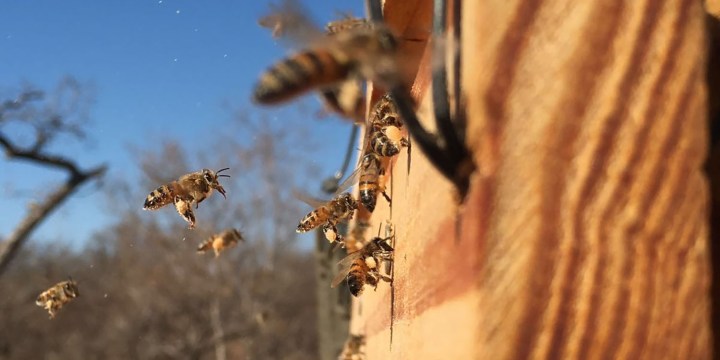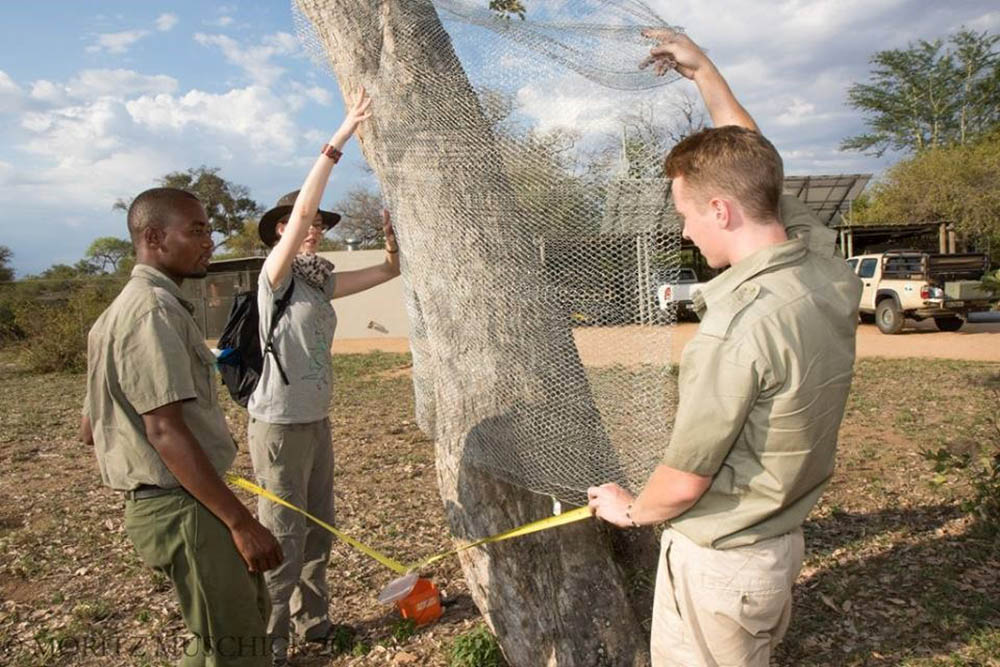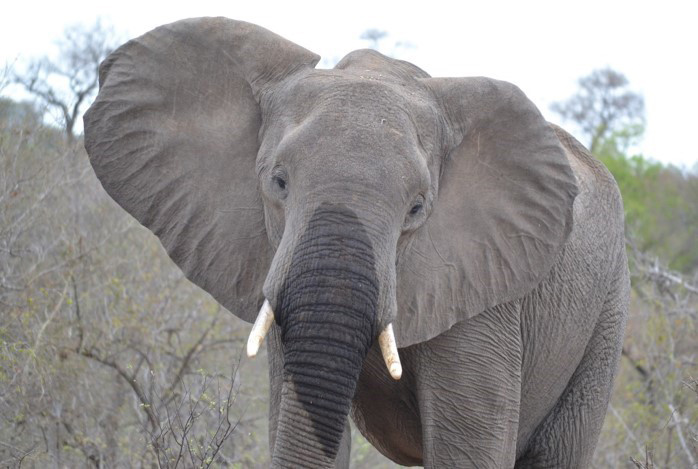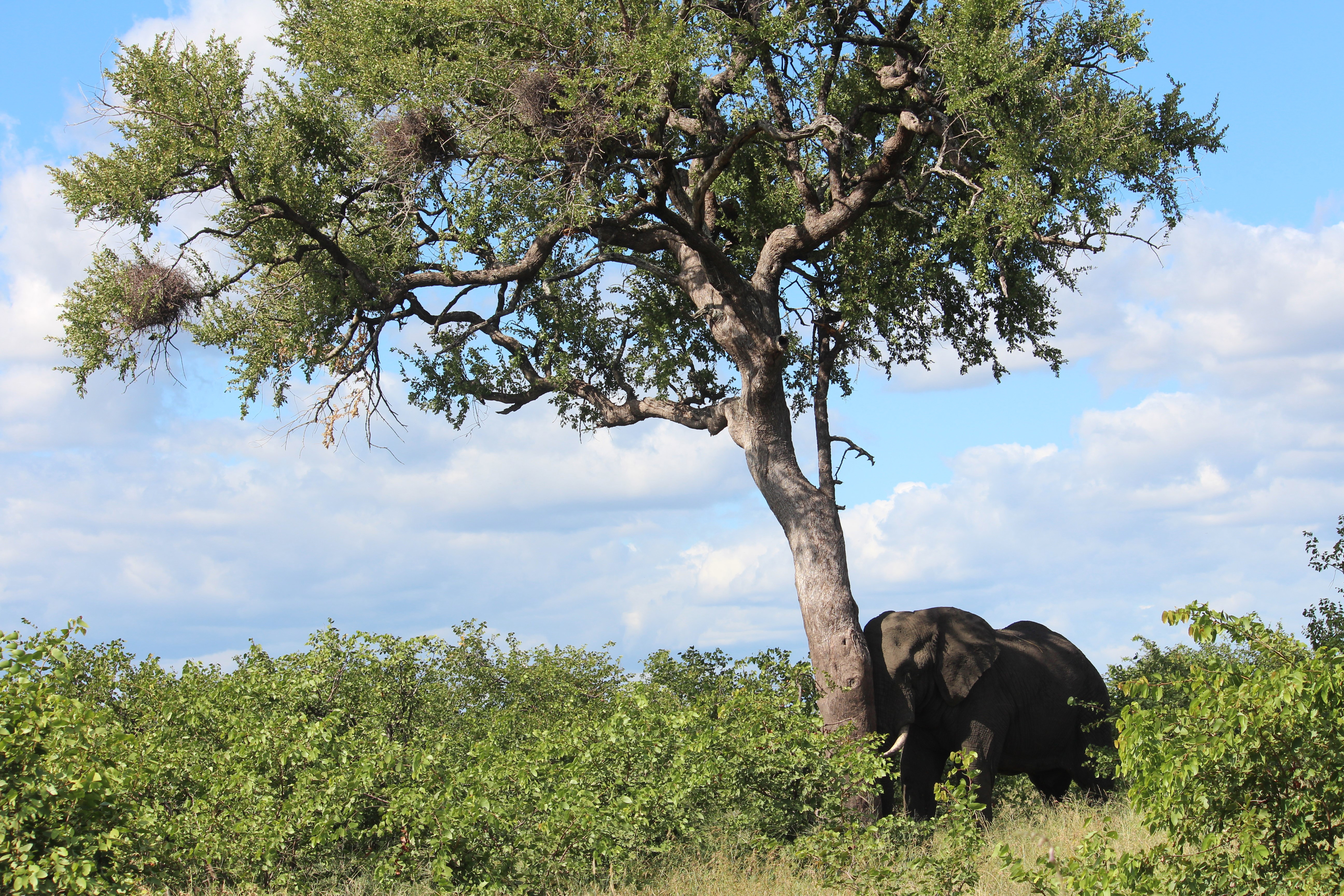DUNG AND DUSTED
Pungent potions deployed to stop elephant tree-muggers

Elephants have been described as ‘nature’s ecological engineers’, and can fundamentally alter the landscapes around them as they forage, damaging or killing large trees. Now researchers are experimenting with smelly solutions to the problem.
Elephants can topple or damage very large trees when feeding on their bark, roots, branches or sweet wild fruit.
But private landowners next to the Kruger National Park have some tricks up their sleeves. They are experimenting with several surprise “weapons” to deter the hungry behemoths from damaging certain iconic trees – including a smelly paste of fermented elephant dung that is smeared over the trunks of these large trees.

Chicken wire netting is wrapped around large and iconic trees to deter bark-stripping. (Photo: Robin Cook and Moritz Muschick)
“There is anecdotal evidence that animals avoid feeding too close to where they defecate,” says Robin Cook, the Big Tree projects manager of the Hoedspruit-based Elephants Alive research and conservation group.
Cook and senior colleague Dr Michelle Henley presented some of their recent elephant management research work to fellow scientists and conservation managers at the annual Conservation Symposium in Howick, KwaZulu-Natal, on 6 November 2019.

Creosote stains the trunk of an elephant. (Photo: Ronny Makukule)
Henley, the co-founder of Elephants Alive, noted that elephant bulls can excrete up to 150kg of dung per day, helping to fertilise the soil and to disperse seeds up to 65km away during their daily foraging trips.
The acids in an elephant’s digestive tract also help to soften and promote the germination of certain tree seeds, which are then excreted in fertile parcels of rich mulch containing semi-digested plant matter.

Sharp rocks placed around the base of large trees help to deter hungry elephants. (Photo: Robin Cook)
However, as much as elephants play a crucial role in shaping nature through the propagation of large trees such as marula (Sclerocarya birrea), knobthorn (Senegalia nigrescens) and red bushwillow (Combretum apiculatum), they also knock down, damage or ring-bark mature specimens, causing extensive damage to vegetation in the vicinity of regular watering holes.
To limit damage to certain vulnerable or iconic tree species in fenced-off conservation areas, Elephants Alive has been researching the cost-effectiveness of a wide variety of non-lethal tree protection methods, mainly on privately-owned wildlife reserves next to Kruger National Park under the umbrella of the Association of Private Nature Reserves.

Dr Michelle Henley. (Photo: Tony Carnie)
Cook says much of this work has centred around marula trees, a species that reaches heights of 18m and produces a sweet-tasting fruit rich in vitamin C.
Some of these methods are surprisingly simple – and cheap.
For example, sheets of metal chicken-wire netting can be wrapped around the trunk of a tree to reduce damage from bark-stripping by elephants, at a cost of R100 per tree.

Robin Cook. (Photo: Tony Carnie)
To ensure that this cage of wire netting does not strangle the tree as it grows, an extra length of the netting is pinned to the tree trunk during installation, so that it can be stretched out and adjusted periodically as the tree circumference expands.
Monitoring tests suggested that only 2% of trees protected by wire netting suffered from elephant bark-stripping compared to 32% of the control specimens with no wire netting.
Another cheap and simple solution – first developed by conservation managers in the Kruger National Park – is to place several sharp, triangular-shaped shards of rock around the circumference of trees, to a distance of up to 5m from the stem.
This “rock pyramid” deterrent is also based on anecdotal evidence that elephants will avoid potential pain or injury to their sensitive foot pads and rather move on to unprotected trees.
Cook said research by Elephants Alive showed that 60% of the 80 monitored trees that were protected by rock pyramids were still alive after 13 years.
Some landowners have also been experimenting with a variety of smelly deterrents.
This has included fermenting elephant and buffalo dung, according to tree researcher Riaan van Zyl, who first started using the method in Botswana. The paste is then smeared over tree trunks.
“We will be testing whether adding hot chilli extracts to the mixture will spice things up a bit and lead to greater avoidance by elephants,” said Henley.
Though cheap, the effectiveness of this method has not been determined yet and may also be limited by the need to smear fresh coatings of dung onto trees on a regular basis as the smell fades.
Cook said he became aware of another smelly deterrent in 2017, when some reserve managers started placing creosote in open, glass jars and tin cans which are affixed to tree trunks.
Creosote is a thick and toxic dark-brown liquid derived from crude oil or coal which is often used to preserve outdoor timber from termites and other wood-eating insects.
While this method enjoyed brief success and popularity on some reserves, Cook said that Elephants Alive asked for it to be discontinued as the method was not effective and a number of elephants have been seen with creosote stains on their trunks and foreheads after accidentally dislodging the jars and cans placed on tree trunks.
Other odour experiments still under way include neem oil, again first suggested by Van Zyl.
One of the most successful deterrents so far, Cook said, involves suspending one or more bee hives on tree branches.
This deterrent is based on several research projects outside the Kruger Park and has also been used by subsistence farmers in other parts of Africa and Asia to protect their crops. Using bees to protect crops was extensively tested by Dr Lucy King.
Cook told the Howick symposium that only 8% of trees protected with bee hives were damaged by elephants, compared to 80% of control trees.
Though this method costs between R600 and R5,000 per tree, some of the costs could be recouped through the sale of eco-friendly honey produced in the hives.
A new bee-deterrent experiment was due to start shortly. This research would involve compounds derived from honeybee “attack” pheromones.
Elephants Alive researchers have partnered with Professor Mark Wright (University of Hawaii at Mānoa) and Transfrontier Africa to investigate the potential of honeybee alarm pheromones to deter wild and semi-captive elephants. The synthetic alarm pheromone experiment is known as SPLAT (Specialised Pheromone and Lure Application Technology) and will explore the potential for synthetically produced semiochemical blends of honeybee attack pheromones using iso-amyl acetate and 2-heptatone compounds.
The experiments are based on evidence that honeybees release a specific pheromone when attacking, and that elephants have an acute sense of smell and fear of bees, leading to their avoidance of areas with either bees or potentially their pheromones. DM
This story forms part of Roving Reporters coverage of the 2019 Conservation Symposium. Click here to read other stories in the series.

















 Become an Insider
Become an Insider